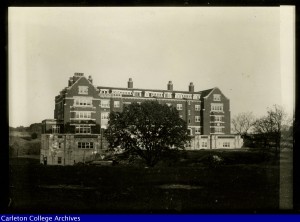
Evans Hall
Traversing the Archives
I decided to choose Evans Hall to attempt to model it in SketchUp. The process of sifting through the Carleton College archives was a bit confusing at first, but then it became easier once I realized a few things. I first started to search for images by searching through the books that were provided by the library. I only came up with one picture of Evans Hall and the rest of it was text either mentioning Evans Hall or Margaret Evans. Then I realized that there were links on the library website to search the Carleton College archives.
Writing the Metadata
Once I found that link, it was easy to find pictures of Evans Hall. There were a lot of pictures of Evans Hall in the stages of it being built, but not that many pictures of the hall complete. I couldn’t find a picture of Evans from the back, only from the front and sides. Now that all of the pictures were collected, it was time to enter in the metadata. At first I found it cumbersome to enter in the metadata since I was not familiar with the format. Also, some of the information that was on the excel spreadsheet I could not find in the details of the picture. However, now there is a lot more information about the pictures by transcribing the metadata.
Pros/Cons of Metadata
I have used the process of writing down metadata before in research projects. I would write down all of the important information about a book, source, or picture so it would be easier to site it later on. I only have used metadata at a very basic level, not making spreadsheets with a comprehensive list of all of the information possible from a source. I can see that metadata is useful as all of the information of the source is in one spot. You can also manipulate or analyze the metadata to tell you something about the sources. However, typing in the metadata takes a long time and all the information that is gathered is not necessarily going to be used. Also, it is hard to find some of the information for the metadata and the formatting can be a bit confusing sometimes. Overall, I enjoyed learning how to find sources, gather the metadata, and put the metadata in a spreadsheet.
I had a lot of the same experiences when I was doing this too! Especially concerning navigating through the archives. The organization of it just wasn’t intuitive to me, and I also ended up looking through books or magazines at times. Good post!
I feel the same way! The search function can be a little bit clunky and unhelpful at times, similar to how the main Carleton website’s search function is pretty terrible. I love that the archival staff has made these materials openly available, but I do wonder if the method of searching limits who will interact with them.
Joseph,
Like you, I find searching the online archives to be overly confusing at times. This is partly due to institutional inertia; I just had a conversation with someone in AT the other day about the fact that our library’s version of contentDM (the CMS that hosts the digital collections) is not the most recent and has not been customized at all. Blossom raised a good point: what good are online materials if the user experience is poor enough to drive people away before they find anything of worth?
It’s a question we should all consider when building digital projects.